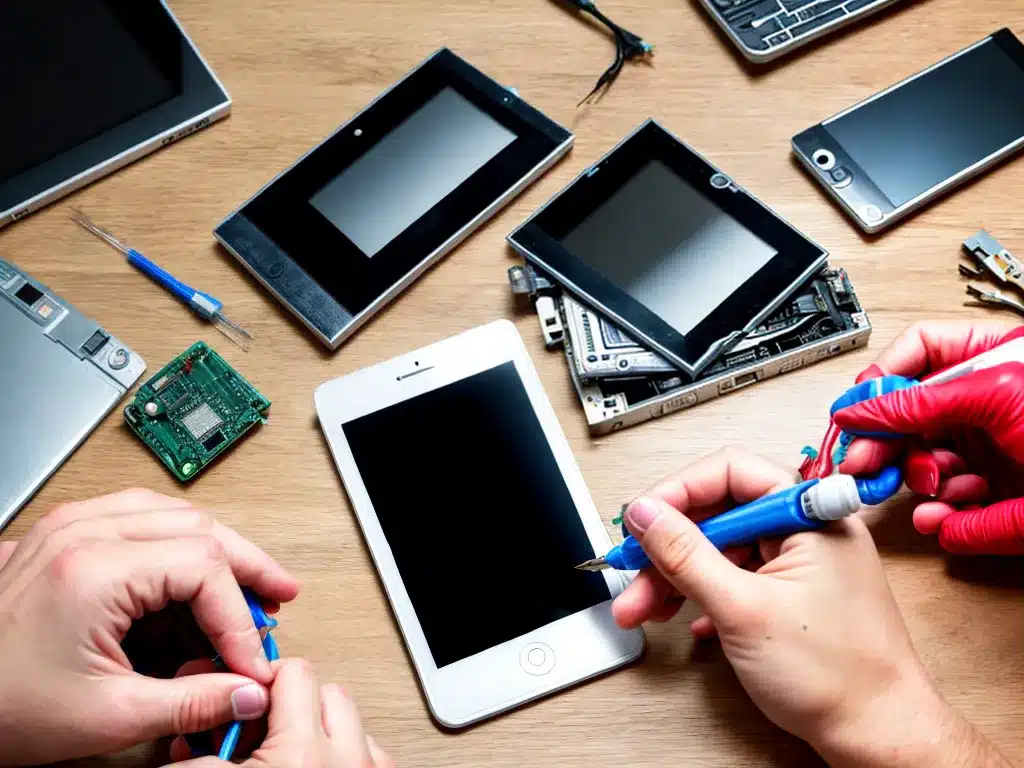
Assessing the Damage
When electronics get exposed to liquid, it’s important to quickly assess the extent of the damage. Here are some key things to consider:
-
What type of liquid was spilled? Water, coffee, juice, etc. Acidic liquids like coffee can corrode metal components faster.
-
How much liquid got into the device? A few droplets or was it fully submerged? More liquid means more damage.
-
Which components got exposed? The screen, keyboard, circuit boards, etc.
-
Are there visible signs of damage? Corrosion, shorts, electrical arcing, etc. Visible damage points to deeper issues.
-
Is the device turning on? If it won’t power on at all, that’s a bad sign.
-
Is it working normally? Test all functions. Partial failure points to localized damage.
-
Take it apart and inspect the interior. Look for residue, corrosion, shorted circuits.
Thoroughly assessing the type of damage helps determine the best repair approach.
Cleaning Up the Liquid
Once the damage is assessed, the first step is cleaning up any remaining liquid inside the device.
-
Use absorbent materials like paper towels to soak up liquid. Cotton swabs and pipe cleaners are good for small spaces.
-
Do not turn on the device until all liquid is removed. Powering on could short circuit it.
-
Remove any displaced liquid by tilting the device and letting it drain out.
-
Remove batteries and detach any cables/peripherals. Checking sockets and ports for moisture.
-
Use isopropyl alcohol and cotton swabs to clean up leftover residue. Be gentle around delicate components.
-
Dry all parts thoroughly before reassembling. Any lingering moisture can damage circuits.
-
Use a hairdryer on a low setting to help evaporate any hidden liquid in crevices.
Thorough drying helps prevent shorts, corrosion, and other moisture-related failures.
Checking for Damage
Once the device is cleaned and dried, it’s time to check for any permanent damage:
-
Power it on and test all functions. Make note of any instability or malfunctions.
-
Check ports and buttons for proper response and fit. Damage can loosen connections.
-
Inspect circuit boards closely under bright light for corrosion, burnt spots, or damaged traces.
-
Check batteries and charging system. Liquid can short these out and prevent charging.
-
Test screen pixels for any darkened areas which indicate shorts.
-
Replace any warped or corroded mechanical parts. Liquid can degrade plastic and metal.
-
Diagnose issues with diagnostic software and multimeter measurements. Test voltage levels, continuity, resistance.
-
Assess whether issues are repairable. Sometimes, corrosion and shorts permanently damage components.
Thorough inspection reveals what repairs are needed. If damage is too severe, the device may need to be replaced.
Making Repairs
Once liquid damage assessments are complete, it’s time to make repairs:
-
Clean corrosion from metal parts with isopropyl alcohol. Use abrasives lightly if needed.
-
Replace shorted or corroded electronic components. Match new parts to original specifications.
-
Repair damaged circuit board traces with solder and insulation. Seek professional microsoldering help if needed.
-
Replace batteries, charging ports, buttons, other physical parts that got corroded.
-
Carefully dry out paper cones and voice coils in speakers damaged by liquid.
-
Inspect screens for dead pixels and replace screen if damage is substantial. Professional installation is recommended.
-
Reapply any conformal coatings stripped off by the liquid. This prevents future shorts.
-
Test repairs thoroughly, powering on and checking all functions. Ensure issues are fully resolved.
With the right repairs, it is often possible to successfully revive electronics exposed to liquid. Some damage may be permanent, though.
Prevention Tips
Here are some tips to help prevent liquid damage in the future:
-
Keep drinks away from electronics. Use cups with lids near devices.
-
Do not use devices near sinks, tubs, pools, bathrooms where splashing can occur.
-
Shut down and unplug devices before moving them to reduce spilling risk.
-
Use waterproof cases for electronics used outdoors like phones and GPS units.
-
Keep devices away from little children and pets who may spill on them.
-
** Handle devices carefully** yourself. Don’t fumble or juggle. Set down gently.
-
Keep absorbent materials handy to soak up spills right away.
-
Learn proper cleaning methods so any liquid is removed safely.
With some care and planning, many liquid damage situations can be avoided. Quick response when spills do occur helps minimize damage.
When to Seek Repair Help
For minor liquid damage, DIY repairs may be possible. But for moderate to severe cases, seek professional assistance:
-
If repairs require disassembling compact devices, it’s easy to break delicate components. Experience is needed.
-
Diagnosing issues like shorted circuits, corrupted memory, requires expertise most people lack. A repair shop can isolate problems.
-
Microsoldering damaged circuit boards takes specialized tools and skills. Mistakes can ruin the device.
-
Replacing screens, batteries and other complex components is difficult without training and usually requires special tools.
-
If the device is still under warranty, repairs by an unauthorized party can void coverage. Go through approved channels.
-
Recurring failures after DIY repairs may mean there is still unresolved damage. Get a second opinion from a professional.
Don’t risk making permanent mistakes trying to fix heavily damaged electronics yourself. Seek qualified repair help when needed.
Conclusion
Quickly drying out and cleaning liquid damaged devices, then making appropriate repairs can often save electronics from permanent failure. Avoiding spills in the first place is ideal. When damage does occur, be sure to assess the situation thoroughly. Simple fixes may be possible yourself, but seek professional assistance for anything complex to avoid making the situation worse. With some care and proper treatment, liquid damaged electronics can be revived.












